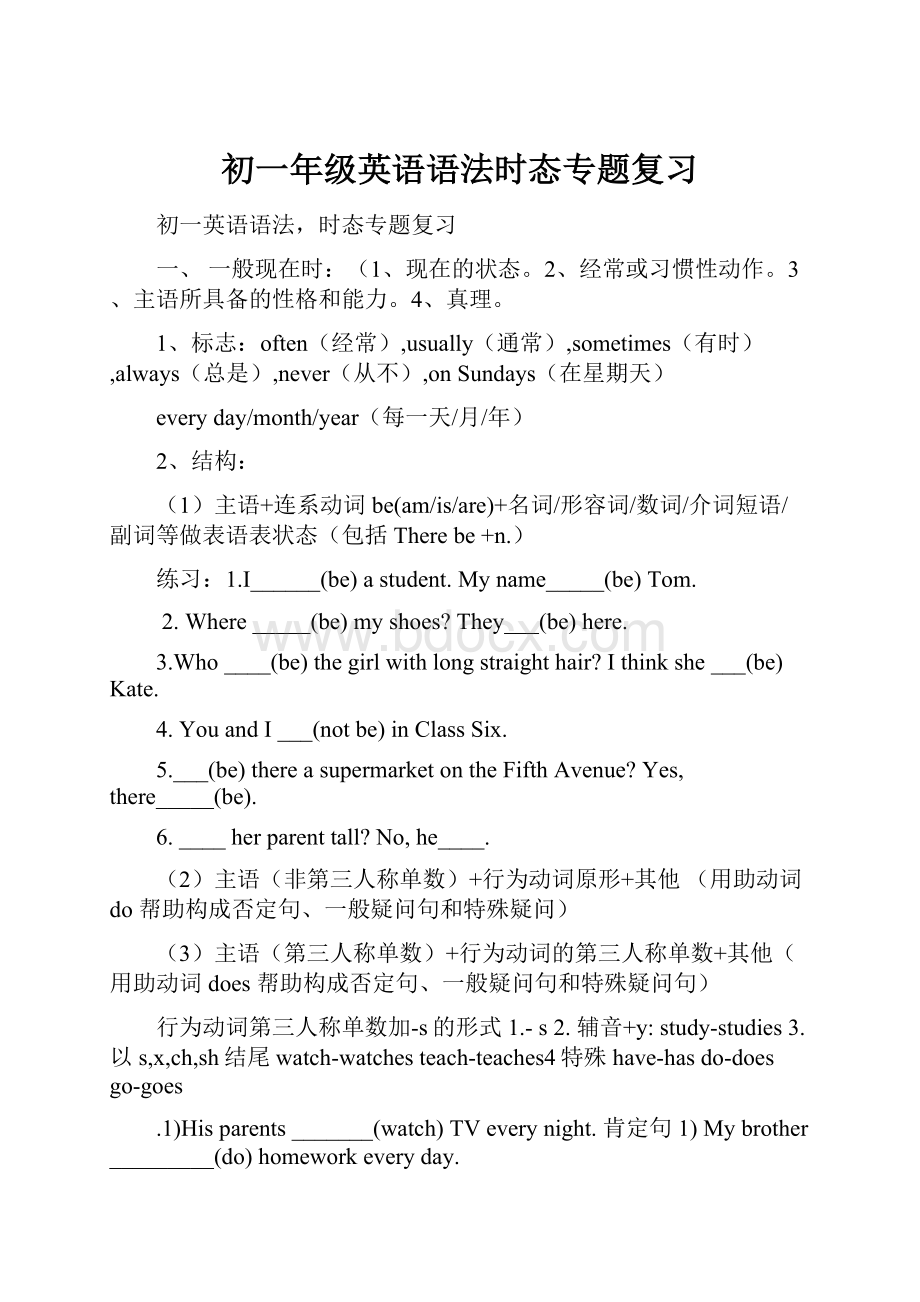初一年级英语语法时态专题复习.docx
《初一年级英语语法时态专题复习.docx》由会员分享,可在线阅读,更多相关《初一年级英语语法时态专题复习.docx(25页珍藏版)》请在冰豆网上搜索。

初一年级英语语法时态专题复习
初一英语语法,时态专题复习
一、一般现在时:
(1、现在的状态。
2、经常或习惯性动作。
3、主语所具备的性格和能力。
4、真理。
1、标志:
often(经常),usually(通常),sometimes(有时),always(总是),never(从不),onSundays(在星期天)
everyday/month/year(每一天/月/年)
2、结构:
(1)主语+连系动词be(am/is/are)+名词/形容词/数词/介词短语/副词等做表语表状态(包括Therebe+n.)
练习:
1.I______(be)astudent.Myname_____(be)Tom.
2.Where_____(be)myshoes?
They___(be)here.
3.Who____(be)thegirlwithlongstraighthair?
Ithinkshe___(be)Kate.
4.YouandI___(notbe)inClassSix.
5.___(be)thereasupermarketontheFifthAvenue?
Yes,there_____(be).
6.____herparenttall?
No,he____.
(2)主语(非第三人称单数)+行为动词原形+其他(用助动词do帮助构成否定句、一般疑问句和特殊疑问)
(3)主语(第三人称单数)+行为动词的第三人称单数+其他(用助动词does帮助构成否定句、一般疑问句和特殊疑问句)
行为动词第三人称单数加-s的形式1.-s2.辅音+y:
study-studies3.以s,x,ch,sh结尾watch-watchesteach-teaches4特殊have-hasdo-doesgo-goes
.1)Hisparents_______(watch)TVeverynight.肯定句1)Mybrother_________(do)homeworkeveryday.
2)Hisparents_________(notwatch)everynight.否定句2)Mybrother________(notdo)homeworkeveryday.
3)_____hisparents_____(watch)TVeverynight?
一般疑3)______yourbrother_____homeworkeveryday?
Yes,they_______.No,they_______.Yes,he______.No,he_________.
4)When___hisparents_____(watch)TV?
特疑4)When_____yourbrother____(do)homework?
TheywatchTVeverynight.Hedoeshomeworkeveryday.
二.现在进行时:
表示说话瞬间或现阶段正在进行的动作。
1、标志:
now(现在)listen(看)look(听)atthemoment(此刻)
2、结构:
主语+助动词be(am/is/are)+行为动词的现在分词(doing)
现在分词的构成:
1.-ing:
eat-eating,sing-singing2.辅音字母+e:
take-taking
3.sit,put,begin,run,swim,stop,get,shop,get(双写最后一个辅音字母,再加ing.)4、特殊变化:
lie-lying,die-dying
练习:
1.Jim__________________(take)photosintheparknow.2.Jim_________(nottake)intheparknow.3._______________Jim____________(take)photosintheparknow?
Yes,he_____.No,he_______.
4.Where_________Jim____________photosnow?
Inthepark.
1.我们正在吃晚餐。
2、我们每天6点起床。
We__________________________.We__________________atsixeveryday.
3.你们在聊天吗?
是的。
4、他们常常聊天吗?
不是。
_______they_______?
Yes,they_____.______theyoften______?
No,they________.
5、他在做什么?
他在做作业。
6、他晚上常干什么?
他常做作业。
What____he___?
He_______.What___heusually___intheevening?
Heusually______.
答案:
1.arehavingdinner2.getup3.Are,talking,are4.Do,talk,don’t
5.isdoing,isdoinghomework6.does,do,does,homework
综合练习:
1.MrGreen_____(be)aworker.Nowhe____(work)inthefield.2.Listen!
Who_______(sing)?
3.Whattime____yourbrotherusually_____(do)hishomework?
4.Youcan_______(come)herebybus.
5.Who____(have)aruler?
6.Arethey_____(clean)theroom?
7.-____you____(eat)dinner?
–Yes,weare.
8.Jack____(have)asoccerball,buthe____(nothave)abasketball.9._______Jim_______(like)______(run)?
10.They_____(be)fromCanada.They______(notspeak)Chinese.11.Hewants_________________(be)tall.
三.一般过去时态:
英语中表示过去某时发生的动作或情况的时态是一般过去时。
1、标志:
yesterday(昨天)、twodaysago…(两天前……)、lastyear…(去年…)、theotherday(前几天)、onceuponatime(很久以前)、justnow(刚才)、intheolddays(过去的日子里)、beforeliberation(解放前…)、WhenIwas8yearsold(当我八岁时…)、at+一个时间点
2.、表现形式:
动词过去式(规则变化和不规则变化两种)
3、规则变化:
(1)一般情况+ed,如pulledvisited
(2)以不发音e字母结尾的单词+d,如liked,danced(3)以辅音字母+y结尾去y变i+ed,worried,studied(4)重读闭音节结尾的单词,末尾只有一个辅音字母双写词尾字母+ed,stopped,shopped
4.不规则变化参考不规则动词表
5、练习:
Heastudent.他曾是一名学生。
否定句Heastudent.一般疑问句heastudent?
肯定回答,.否定回答,.
Theyhadameetinglastnight. 他们昨晚开了一个会。
否定句Theyameetinglastnight.一般疑问句theyameetinglastnight?
肯定回答,.否定回答,.
提问:
theylastnight?
四.冠词:
英语中冠词分为定冠词(the)、不定冠词(a/an)和零冠词(不用冠词)
1.a用于辅音音素(不是辅音字母)前;an用于元音音素(不是元音字母)前。
如,Anhourago,anhonestmanacceptedanhonorabletaskInauniversity,aEuropeanandaone-eyedmanwalkalongaone-wayroadwithausualtool.Thisisausualthing.
2.定冠词the的用法:
定冠词the与指示代词this,that同源,有“那(这)个”的意思,但较弱,可以和一个名词连用,来表示某个或某些特定的人或东西。
(上文提到过的人或事;指世界上独一无二的事物;用在序数词和形容词最高级,形容词等前面;乐器的名词前;用在惯用语中;姓氏的复数名词之前表示一家人专有名词前等等)例如thesun,therich富人,onthesecondfloor,theUnitedStates美国playthepiano,theGreens格林一家人(或格林夫妇)intheday,在白天
3.通常我们在三类名词前不带冠词:
复数可数名词、不可数名词和专有名词。
但是,用来指特定的事物时,the可以出现在复数名词和不可数名词前面。
Girlslikeshoppingwhentheyarefree.女孩总是喜欢在空闲的时候购物
Riceisveryimportanttoourcountry.Chinaisabigcountry.
1.Hehasalreadyworkedfor______hour.A.theB.anC.aD.不填
2.Aliceisfondofplaying______piano.A.theB.anC.aD.不填
五.数词:
基数词和序数词
(一).基数词.
1.基数词的读法.
1)1---12:
onetwothreefourfivesixseveneightnineteneleventwelve
2)13---19:
词尾加-teen:
thirteenfourteenfifteensixteenseventeeneighteennineteen
3)20,30,40,50,60,70,80,90:
逢十词尾加-ty:
twentythirtyfortyfiftysixtyseventyeightyninety
4)21----99:
在十位与个位之间加连字符构成.
5)101---999:
先说几百,再加and,再加末尾两位数或个位数.
101---onehundredandone238----twohundredandthirty-eight
(二).序数词
基数词变序数词,基数词变序数词口诀
一二三,特殊记,结尾字母t,d,d;(firstsecondthird)八减t(eighth),九减e(ninth),f来把ve替(twelfth);ty变y为ie,然后再加th(twentieth);如果遇到遇到几十几,只变个位就可以(twenty-one----twentyfirst)。
(三).数词的应用.
1.序数词前一般加定冠词the
2.hundred/thousand/million/billion
1).若hundred/thousand/million/billion前有基数词时,其后不加s,也不加of.若没有时,既加s也要带of.
Everyyear_______visitorscometoChina.
Therearetwo_______studentsinourschool.
A.thousandB.thousandsC.thousandsofD.thousandof
2).日月年(the+序数词+of+月,年)
2007年3月21日---thetwenty-firstofMarch,twothousandandseven.
六.名词的复数,不可数名词,名词所有格
▉可数名词的复数规则变化
一、直接加S(清辅音后发[s]的音,浊辅音,元音后面发[z]的音,在字母t后面发[ts]的音)
二、以s.x.ch.sh.结尾的单词加es,class----classes,box---boxes,dish----dishes,watch----watches(通常发成[iz])
三、以fe或f结尾的通常变fe或f为v再加esleaf----leaves,knife---knives
四、辅音字母加y结尾的,变y为i再加esbaby---babies
五.元音字母加y结尾的直接加smonkey----monkeystoy----toys
六.以o为结尾变复数有的加s,piano---pianos,photo---photos,有的加es,黑人(Negro)英雄(hero)爱吃西红柿(tomato)土豆(potato)有时也吃一点(mango)但最喜欢的还是zero(零)
▉可数名词的复数不规则变化:
child→children,man→menwoman→women,foot→feettooth→teeth,mouse→mice;sheep,Chinese,Japanese,people单、复数同形
▉不可数名词:
物质名词或抽象名词,及动名词,一般都是不可数名词,不可数名词只有单数形式。
如,news新闻advice建议water水ice冰tea茶meat肉milk牛奶age年龄time时间help帮助luck运气work工作swimming游泳
▉名词所有格:
名词所有格的用法所有格’s或s’形式主要用于人或一些动物的名称,表示"所有"或修饰的关系。
如John’sfather约翰的父亲,spiders’web蜘蛛网;事物的的所有格常用of表示,如amapofchina,aphotoofmyfamily
七.介词:
一、早、下午、晚要用in例inthemorning/afternoon/evening/day在早上/下午/白天
二、at黎明、午、夜、点与分,例:
atdawn,atdaybreak在黎明时候atnoon在中午atnight在夜间atmidnight在午夜atsixo’clock在6点钟
三、年、月、年月、季节、周,即在"某年","某月",在"某年某月"(具体日则用on),在四季,在第几周等都要用in。
in1986在1986年inApril在四月inDecember19861986年12月inspring在春季insummer在夏季onMay1st
练习:
1.Webeginclasses_______about8:
00.2.Wealllikeworking______China.3.Whatdoyoulikedoing________theevening?
4.OurschoolhasanArtFestival________December31steveryyear.5.Whatcanyousee________thepicture?
.6.Thespeechcontestis_____January.
八.人称代词:
我你他她它我们你们他/她/它们
主格:
Iyouhesheitweyouthey
宾格:
meyouhimheritusyouthem
形容词性物主代词:
我的你的他的她的它的我们的你们的他/她/它们的
myyourhisheritsouryourtheir
名词性物主代词:
mineyourshishersitsoursyourstheirs
练习:
1.________(我)amaworker._________(你)areadoctor.______(她)isateacher.
2.Thisis(他的)shirt.
3.Thisis__________(我的)pen.
4._________(他们的)trousersarethere.
5.Ilikethispicture.Pleasegive________(它)to________(我).
6.Peopleget________(他们的)moneyfrom_________(我).
7._____(他们)arenewstudents._____(他们的)namesareLucyandLily.
8.Theseare_____(我们的)shoes.Can____(我们)wear______(它们).
9.Thank_______for_______(你的)help.
10._______(他)loves_______(她),and_______(她)loves_______(他),too.
_______(我)love_________(你),and________(你)love_______(我),too.
九.情态动词:
1、任何主语+can/may/must等+动词原形2、主语+can’t/maynot/mustn’t等+动词原形
3、Can/May/Must等+主语+动词原形?
4、疑问词+can/may/must等+主语+动词原形?
练习:
youswim?
Yes,butI’mnotagoodswimmer.A.CanB.MayC.NeedD.Must
Tom,youplaycomputergamestoomuch.It’sbadforyoureyes.A.mustn’tB.didn’tC.needn’tD.wouldn’t
十.非谓语动词(是固定搭配)
1.like+todo不定式/doing动名词2.wanttodosth.3.lovetodo4.wouldliketodosth.
5.enjoydoingsth.6.thanksfordoing7.stopdoingsth8.letsb.dosth.
Shewants_____(have)aparty.Doeshelike_______(swim)?
Thanksfor_______(enjoy)CCTVshow.Sheneverstops____(talk).
十一.祈使句:
无人称、动词开头,带命令色彩的句子。
Gostraightandturnleft/right.否定→Don’tgostraightandturnleft/right.
GothroughFifthAvenue.否定→Don’tgothroughFifthAvenue.
Takeataxi(Takeabus,Takeawalk……)否定→Don’tTakeataxi(Takeabus,Takeawalk……)
Noparking.禁止停车。
例_____inthestreet.It’sdangerous.A.Notplay B.NottoplayC.Don’tplay D.Don’ttoplay
十二.感叹句
感叹句的结构:
what+a/an+形容词+名词+主谓Whatacleverboyheis!
他是多么聪明的孩子啊
Whataninterestingbookyouhave!
你的书多么有趣啊!
what+形容词+名词复数:
Whatcleverboysyouare!
你们是多么聪明的孩子啊!
what+形容词+不可数名词:
Whatdifficultworkitis!
那是多么困难的工作啊!
How+形容词/副词+主语+谓语!
Hownicesheis!
Howfastheruns!
练习:
1.Itisquiteanicepresent.→__________nicepresent(itis)!
→_____nicethepresentis!
2.Wehavefineweathertoday.→__________weatherwehavetoday!
3.Thechildrenareworkinghard.→__________thechildrenareworking!
4.Sheplayedbasketballwonderfully.→__________sheplayedbasketball!
十三.Therebe(be单复数由be后名词决定)句型表示某地有,have/has,主要表示某人有
句型转换
1)Thereisabankonthestreet.2)Therearesomecarsinfrontofthepark.
否定句:
There_______abankonthestreet.否定句:
There_____________carsinfrontofthebank.
一般疑问句:
_____________abankonthestreet?
一般疑问句:
________________carsinfrontofthebank?
就划线部分提问:
________onthestreet?
就划线部分提问:
__________infrontofthebank?
There’sabankonthestreet.Therearesomecarsinfrontofthebank.
同上:
________________arethereonthestreet?
同上:
____________arethereinfrontofthebank
There’sonlyone.There’resome.
3)Hetwosons.他有两个儿子。